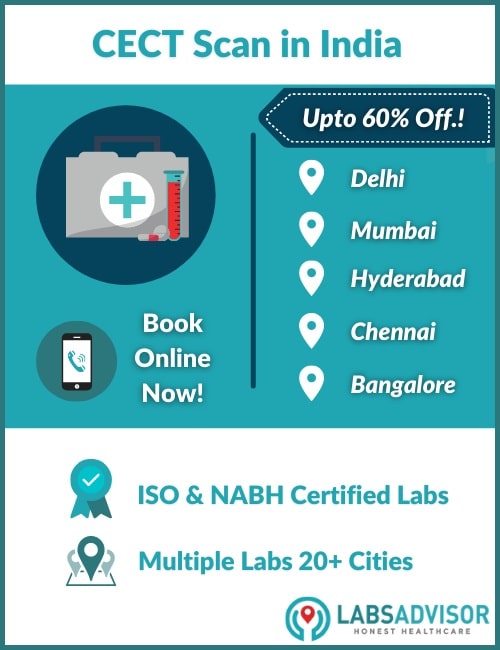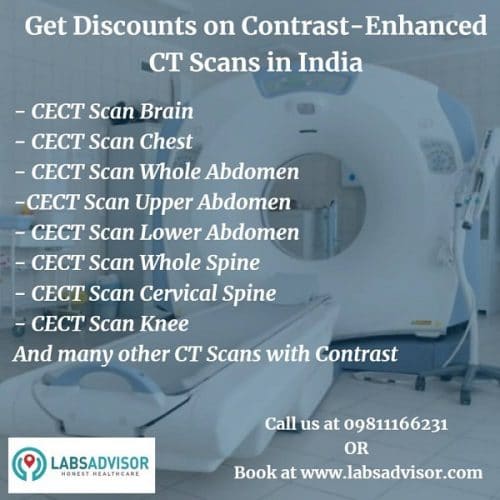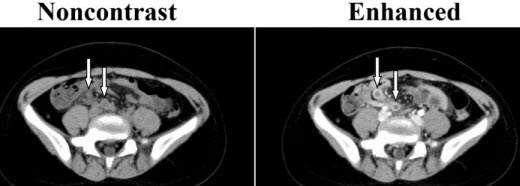
The full form of CECT stands for Contrast-Enhanced Computed Tomography also called a CT Scan with contrast. CECT (contrast-enhanced computed tomography) is an imaging diagnostic method that helps your doctor to take a clearer and closer view of your internal organs and soft tissues in the body.
Book this really important test at your local top-quality labs through us at up to 60% discount. The lowest CECT scan cost in India is ₹1395 only.
CECT Scan in India Through LabsAdvisor
|
CECT scan cost near you in India and Lab Details
Here is the list of top CECT scans and cities providing the scan. To know the updated price click on the links as it may vary. Book online yourself at any time of the day or night.
| CECT Scan Price in India | Prices starting from |
| CECT Scan Whole Abdomen Price in India | ₹4000 |
| CECT Scan Brain Price in India | ₹1395 |
| CECT Scan Chest Price in India | ₹2587 |
| CECT Scan Lower Abdomen Price in India | ₹2950 |
| CECT Scan Upper Abdomen Price in India | ₹3200 |
If your city for the CECT scan is not listed in the table above, call us on +918061970525. We will get back to you with the CECT scan cost near your location in India.
Get the affordable CECT scan cost in India by calling us at
If you want us to call you back, click on the link below

What is the full form of CECT?
CECT stands for Contrast-Enhanced Computed Tomography also called a CT Scan with contrast.
It was previously known as Computerized Axial Tomography (CAT); Computer-Assisted Tomography (CAT); Computerized Tomographic Imaging; and Reconstructive Tomography (RT).
What is a CECT Scan and how it is different from a normal CT scan?
CECT (contrast-enhanced computed tomography) is an imaging diagnostic method that helps your doctor to take a clearer and closer view of your internal organs and soft tissues in the body.
CT (Computed Tomography) scan is a procedure that measures the amount of energy absorbed by tissue during a CT Scan procedure. A CT scan machine is a doughnut-shaped circular machine that emits beams of radiation passing through the patient’s affected body part. The machine also has an attached set of X-ray detectors or special cameras that capture detailed images while revolving around the patients lying in the tubular CT scan machine. A normal CT scan doesn’t involve any use of contrast agents during the process.
Contrast-Enhanced (CE) implies the use of contrast agents during a CT scan examination to highlight specific tissues and parts of the body. A contrast agent is a type of nuclear medicine that reflects radiation while flowing in the bloodstream.
- Nuclear medicines used during CT scans are iodine, gastrografin, and barium.
- It can also be called a radioactive agent, radioactive dye, or radiopharmaceutical.
- It can be transferred into the patient’s body in 3 different ways- through a vein (an intravenous injection), orally (through the mouth), or rectally (through the rectum).
Contrast agents are also used in CT angiography.

Which body parts are mostly recommended for CECT scans by doctors?
CECT whole abdomen
CT scan whole abdomen is done as a combination of CT upper abdomen and CT lower abdomen scans. It is called a CECT Abdomen if it involves the use of a contrast agent during the process.
CECT whole abdomen includes the imaging of the whole abdominal cavity starting from the thoracic diaphragm to the pelvic groin. During the procedure, a small dosage of a contrast agent is injected or given orally that improves the visualization of organs in the reproductive system, intestinal system, digestive system, excretory system, and all the other organs. A CECT scan also helps to track the blood supply to the organs.
An abdominal CECT is typically used to help diagnose the cause of abdominal pain and diseases such as:
- cancer or tumor,
- appendicitis (a condition in which the appendix becomes inflamed),
- diverticulitis (infection in the digestive tract),
- conditions affecting kidney and gallbladder,
- abscesses and inflammations,
- pancreatitis,
- vascular disorders.
Your doctor may also ask for a CT scan abdomen to administer future treatments, guided biopsies, and other medical procedures.
CECT Upper Abdomen
Generally, a doctor recommends a normal CT scan for the upper abdomen. If the results provide no clear indications, your doctor will ask you to go through a CECT scan of the upper abdomen. A CT scan with contrast helps to determine an early diagnosis by showing a better view of the internal organs. It helps in detecting signs of any injury or disease of the liver, infection, or inflammation of the spleen, kidneys, stomach, bladder, intestines, pancreas, and adrenal glands. CECT scan also helps to get a clearer view of the blood vessels and lymph nodes in the abdomen. It is generally ordered to point:
- Gallbladder disease,
- Kidney conditions,
- Liver disease,
- Intestinal disorders,
- Other misguided diseases.
CECT Lower Abdomen
Our lower abdomen and pelvis include the digestive organs as well as the endocrine, urinary and reproductive systems. A contrast-enhanced CT scan lower abdomen or pelvis is an imaging procedure done to diagnose and detect diseases in the small bowel, colon, and other internal organs. It is often recommended when your doctor cannot describe the actual reason for your unexplained pain in the lower abdominal area. The human pelvis area also includes the prostate, bladder, and other female and male reproductive organs, lymph nodes, and pelvic bones. Typically, a CECT scan lower abdomen is to detect:
- Masses or tumors, including cancer
- The cause of pelvic pain
- Injury to the pelvis
Most of the medical centers examine CECT lower abdomen as a combination of the lower abdomen and pelvis regions.
CECT Chest
Your doctor will recommend a CT Scan with contrast or CECT (Contrast-Enhanced Computed Tomography) scan for your chest when they will need to see better images of certain areas of lungs to determine the potential disease. This scan mainly concentrates on lungs and other related disorders. It can diagnose lung cancer at early stages and detect blood clots or other internal injuries that are often not visible on a normal CT scan chest.
During the procedure, a radioactive substance will be given to the patient either orally or through injection prior to the test. The radioactive substance will be absorbed by the body and will interact during the scanning to produce vivid images of the lungs, heart, esophagus, or major arteries.
CECT Brain
The CECT brain is also known as the CECT scan head. It is done to find various disorders or conditions in the brain of the patient. It is mainly done to determine:
- the cause sudden paralysis, sudden vision impairment, frequent loss of consciousness, strokes or unexplained continuous headaches,
- a brain injury,
- a brain tumor,
- an aneurysm,
- internal bleeding,
- issues in the middle ear bones or auditory nerve.
How is a CECT scan performed?
A small and sterilized needle is injected into a vein in the hand or arm by your radiologist and it will be held in place with tape or a strap. Once the needle is inserted into the vein, it is flushed with a saline solution. Then the contrast agent is injected into the same capsulated syringe. Once the contrast agent enters your body it circulates through the heart and passes into the arteries. It transfers to the affected body part through the small blood capillaries.
The patient is asked to lie on the examining table that will slide inside and out of the CT scan machine during the process. The contrast agent will enhance the visibility of the flowing blood in the vessels under the X-ray beams. A set of detailed 2D images will be acquired.
The kidneys and liver eliminate the contrast from the blood.
Click on the link if you want to read more about CT scan → A Complete Guide to CT Scan
Is there any preparation required?
A normal CT scan has basic required preparations. And a CT scan with contrast has different basic and important needs during the process that is expected to be followed by the patient. It includes:
- Not to drink or eat anything for an hour to several hours prior to the scan.
- Make sure you do not go for more than one CT contrast study within a span of 48 hours.
- Get a kidney function test and serum creatinine test done before your CECT scan.
- Preferably consume clear liquids before the night of your scan.
- Wear simple and loose clothes during the scan, without any embellishments, snaps or metallic ornaments.
Your doctor may ask you to wait for some time after giving a small dosage of nuclear medicine, as the contrast agent may need some time to absorb into the body.
Consult your doctor before the exam and clear all your doubts related to the scan.
Are there any risk factors in the scan?
There are some concerning risks of CECT examination but the benefits of using iodine contrast typically outweigh the risks. The risks can be:
- Allergy to the patients who have diabetes, asthma, a heart condition, kidney problems, or thyroid conditions
- A warm and metallic sensation while injecting the iodine, which usually lasts less than a minute or so.
- There can be other visible reactions of medicine such as itching, rashes or bumps on the skin. This type of reaction is usually treated with medication.
- There are symptoms of breathing difficulty, swelling of the throat, or swelling of other body parts.
- Often patients have stomach cramps, diarrhea, nausea, vomiting or constipation
What can be expected from a CECT scan report?
Generally, the results are available in a day or two after your scan. And your concerned doctor is in the right position to interpret your results.
A contrast-enhanced report gives more intense information on the affected part of the body.
- It gives a sharp view of the soft tissues and internal organs,
- The image will be in black and white. The brighter spots will show the blood flow to the organ.
Interesting topics you may look for:






